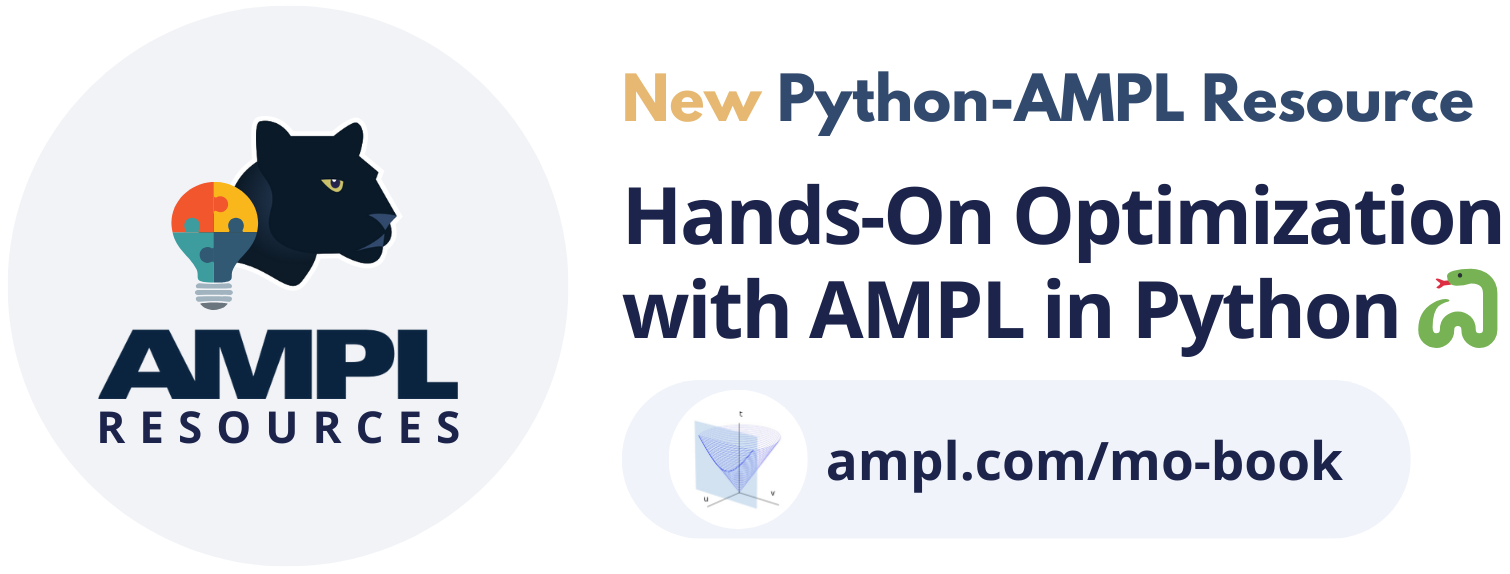# Install Python API for AMPL
$ python -m pip install amplpy --upgrade
# Install solver modules (e.g., HiGHS, CBC, Gurobi)
$ python -m amplpy.modules install highs cbc gurobi
# Activate your license (e.g., free https://ampl.com/ce license)
$ python -m amplpy.modules activate <license-uuid>
# Import in Python
$ python
>>> from amplpy import AMPL
>>> ampl = AMPL() # instantiate AMPL object# Minimal example:
from amplpy import AMPL
import pandas as pd
ampl = AMPL()
ampl.eval(r"""
set A ordered;
param S{A, A};
param lb default 0;
param ub default 1;
var w{A} >= lb <= ub;
minimize portfolio_variance:
sum {i in A, j in A} w[i] * S[i, j] * w[j];
s.t. portfolio_weights:
sum {i in A} w[i] = 1;
""")
tickers, cov_matrix = # ... pre-process data in Python
ampl.set["A"] = tickers
ampl.param["S"] = pd.DataFrame(cov_matrix, index=tickers, columns=tickers)
ampl.solve(solver="gurobi", gurobi_options="outlev=1")
assert ampl.solve_result == "solved"
sigma = ampl.get_value("sqrt(sum {i in A, j in A} w[i] * S[i, j] * w[j])")
print(f"Volatility: {sigma*100:.1f}%")
# ... post-process solution in Python[Documentation] [AMPL Modules for Python] [AMPL on Streamlit] [AMPL on Google Colab] [Community Edition]
amplpy is an interface that allows developers to access the features of AMPL from within Python. For a quick introduction to AMPL see Quick Introduction to AMPL.
In the same way that AMPL’s syntax matches naturally the mathematical description of the model, the input and output data matches naturally Python lists, sets, dictionaries, pandas and numpy objects.
All model generation and solver interaction is handled directly by AMPL, which leads to great stability and speed; the library just acts as an intermediary, and the added overhead (in terms of memory and CPU usage) depends mostly on how much data is sent and read back from AMPL, the size of the expanded model as such is irrelevant.
With amplpy you can model and solve large scale optimization problems in Python with the performance of heavily optimized C code without losing model readability. The same model can be deployed on applications built on different languages by just switching the API used.
Data can be loaded in various forms:
More notebooks with examples available on the AMPL Model Colaboratory.
- GitHub Repository: https://github.com/ampl/amplpy
- PyPI Repository: https://pypi.python.org/pypi/amplpy
- Conda-Forge: https://anaconda.org/conda-forge/amplpy
Install from the PyPI repository:
python -m pip install amplpy
AMPL and all Solvers are now available as Python Packages:
-
Install Python API for AMPL:
python -m pip install amplpy --upgrade -
Install solver modules (e.g., HiGHS and Gurobi):
python -m amplpy.modules install highs gurobi -
Activate your license (e.g., free AMPL Community Edition license):
python -m amplpy.modules activate <license-uuid> -
Import and instantiate in Python:
$ python >>> from amplpy import AMPL >>> ampl = AMPL() # instantiate AMPL object
Install from the Conda repository:
conda install -c conda-forge amplpy
For air-gapped installations we recomend the following:
- Download on another machine the
.whlfile for the corresponding platform and python version from pypi. - Install on the target machine with:
python -m pip install amplpy-version-python_version-*-platform.whl --no-deps
You can build and install the package locally as follows:
$ git clone https://github.com/ampl/amplpy.git
$ cd amplpy
$ python dev/updatelib.py
$ python setup.py build
$ pip install . --upgrade
BSD-3
Copyright © 2024 AMPL Optimization inc. All rights reserved.


